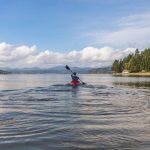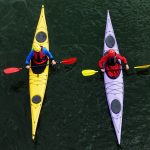Welcome to our guide on kayak scupper plugs! If you’re a seasoned kayaker or just starting out, you may have heard about scupper plugs and wondered what they are and why you need them.
Scupper plugs are small, often inexpensive, accessories that can make a big difference in your kayaking experience. They’re designed to fit into the scupper holes in your kayak, which are the drainage holes that allow water to flow out of the cockpit.
In this guide, we’ll cover everything you need to know about kayak scupper plugs, including why you might want to use them, how to choose the right ones for your kayak, and some of the best options available on the market today.
So, whether you’re looking to keep your feet dry or just want to make your kayak more comfortable, read on to learn all about kayak scupper plugs.
What Are Scupper Plugs?
Small rubber or plastic components that prevent or close off the drain holes on a kayak designed to be sat on top are known as scupper plugs. The shape of the plugs vary depending on the style of sit-on-top kayak they are intended to be used with.
Most sit on top kayaks can use universal scupper plugs.
These plugs are crafted from rubber and possess a thin strand that helps with taking the plugs out when they are not required anymore.
Some scupper plugs are made with a screw-in design. If you decide to go with this blueprint, make certain that the plugs you select are suitable for your kayak.
The most effective scupper plugs form a tight seal and are straightforward to put in and take out.
It is quite easy to make use of them and they are often overlooked kayak accessories that people won’t think about until they are gone and there is more water than desired in the kayak’s cockpit.
Why Are Scupper Holes Necessary For Your Kayaking Safety?
Scupper holes are the openings in the bottom of a kayak that let water flow in and out. The kayaks are built so that they won’t go under if they flip over.
The two main types of kayaks that people use are sit-on-top and sit-in. Sit-in kayaks tend to be the more popular of the two. Sit-in kayaks often include scupper holes which enable water to be drained rapidly when rowing. Holes referred to as ‘scuppers’ can be located by the base of a kayak’s hull, situated in between the two segments of plastic which construct the kayak.
There is normally a single aperture placed on either side of the boat close to the place where your feet would be situated if you were seated inside it. When you move quickly through the water or take a sharp turn, this will allow the water to escape quickly, avoiding the boat from being overwhelmed and flipping over.
A scupper hole is a port that enables water to be emptied from your boat in the event of it overturning, thereby preventing you from drowning. The scupper hole should be situated close to the front or back of the boat so that it does not allow water to come in when the boat is upright and paddling in either direction.
Aid In Ventilation
The scupper holes serve the purpose of ventilation, making the kayak more buoyant, and also helping to make the air more breathable. Nonetheless, the larger size of the craft means that it is harder to regulate, and it may be more demanding to handle the vessel. They are not just for looks but also functionality.
Assist In Keeping The Kayak Afloat
Kayaks typically have small openings in the center. The tiny perforations enable liquid to stream out of the vessel when it is flipped over, facilitating it for seafarers to pick their vessel.
The scupper hole is located on either side of the cockpit, which is below the seating area if you’re paddling. Alternatively, it can be found at the top of the cockpit if you wish to stand.
Aid In Preventing Water From Seeping
The openings on kayaks called scupper holes keep water from coming in. The openings also allow air to escape. Scupper plugs are generally located at the front and back of the kayak. The shape and dimensions vary based on the style of kayak utilized.
Aid In Pressure Relief
Kayaks typically have openings incorporated into their design. However, they can also aid in pressure relief. The scuppers on the cockpit are created to enable water to be removed from the cockpit without it entering and collecting in it, which could result in a hazardous setting.
Scupper plugs are a part on lots of kayaks that let you vent the cockpit and reduce the chance of flipping over. The kayaks are structured in such a way that water can escape out of them through the scuppers, which stops water from amassing inside and making a hazardous setting.
Aid In Water Drainage
Kayaks are designed with holes in them to allow for the removal of water. This allows water to flow out of the kayak. Kayaks need to be equipped with holes on their bottoms and sides in order to help water to flow away.
The self-draining scupper plug allows a bit of water to leave the boat, so that it doesn’t become too full and submerge. Kayaks that have scupper holes can be applied for use in turbulent waters, such as for white-water kayaking. It might be necessary to turn the boat upside down so that the water can be emptied out.
Aid In Egress From A Sinking Kayak
Kayak scupper aid in egress from a sinking kayak. Scupper plugs are openings located on the bottom of a kayak. They permit air to be evacuated from the seating area and enable a fast escape.
Scupper holes provide an easy way to escape a kayak that is going underwater. Rescuers are aided by life preservers when it comes to pulling people from a sinking boat. The length of a scupper hole is typically around 6 inches, with a width of approximately 2 inches.
This is a common technique for when a kayaker has been flipped off their vessel by a swell or has overturned and must get back on the kayak. Additionally, some openings were placed just above the water level so that rowing boat users can remove water from their vessels quickly and easily.
Are The Scupper Holes In The Kayak Risky?
Holes are not always reliable. At times the paddles may be too big or too small for a kayak, creating issues. Verify the size of the scupper Hole prior to purchasing a new kayak or using it the first time.
You should be aware of the consequences of entering a kayaking trip via a scupper hole. Scupper holes have the potential to be hazardous since they can capture someone inside the kayak.
It can be difficult to determine whether a scupper hole is open or shut, particularly when the lighting dims. It is essential for kayakers to be aware and make sure they do not become hindered in their vessel.
Paddling in a kayak is an enjoyable activity that calls for numerous competencies and appreciation of your environment. Recognizing the location of scuppers and figuring out ways to stay out of the boat if one of them happens to be left open is important.
Do You Need Scupper Plugs?
There’s a relatively short answer to this question. The necessity of using scupper plugs in a kayak is mostly determined by the kind of kayak you are using.
Going back to the distant past, it can be seen that ‘scuppers’ were an integral part of ships used for seafaring commerce.
The people discovered they must have openings on the vessel’s exterior surface so rainwater can run out when high waves hit the vessel’s edges.
This is the same principle used in kayaks. Nevertheless, since the top layer of a kayak is nearer to the waves compared to a boat’s, scupper openings make it possible for the sea to enter into the kayak’s cockpit.




